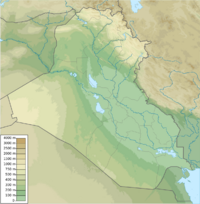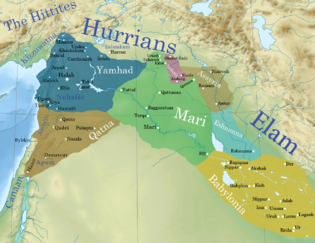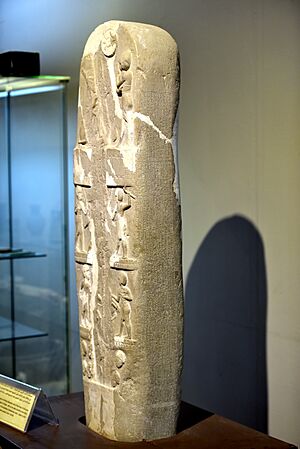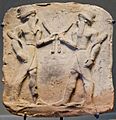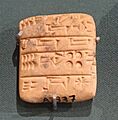Eshnunna facts for kids
| Alternative name | Tell Asmar |
|---|---|
| Location | Iraq |
| Coordinates | 33°29′3″N 44°43′42″E / 33.48417°N 44.72833°E |
| Type | settlement |
| History | |
| Founded | Late 4th Millennium BC |
| Periods | Bronze Age |
| Cultures | Early Dynastic, Akkadian, Ur III, Isin-Larsa, Old Babylonian |
| Site notes | |
| Excavation dates | 1930 to 1936, late 1990s |
| Archaeologists | Henri Frankfort, Seton Lloyd, Thorkild Jacobsen |
| Condition | Ruined |
| Ownership | Public |
| Public access | Yes |
Eshnunna (modern Tell Asmar in Diyala Governorate, Iraq) was an ancient Sumerian (and later Akkadian) city and city-state in central Mesopotamia 12.6 miles northwest of Tell Agrab and 15 miles northwest of Tell Ishchali. Although situated in the Diyala Valley northwest of Sumer proper, the city nonetheless belonged securely within the Sumerian cultural milieu. It is sometimes, in archaeological papers, called Ashnunnak or Tuplias.
The tutelary deity of the city was Tishpak (Tišpak) though other gods, including Sin, Adad, and Inanna of Kititum were also worshiped there. The personal goddesses of the rulers were Belet-Šuḫnir and Belet-Terraban.
Contents
History
Early Bronze
Inhabited since the Jemdet Nasr period, around 3000 BC, Eshnunna was a major city during the Early Dynastic period of Mesopotamia. It is known, from cuneiform records and excavations, that the city was occupied in the Akkadian period though its extent was noticeably less than it reached in Ur III times. Areas of the Northern Palace date to this period and show some of the earliest examples of widespread sewage disposal engineering including toilets in private homes.
The first known rulers of the city were a series of vassal governors under the Third dynasty of Ur. Eshnunna may have had special relationships to the royal family. For example, Shulgi's wife Shulgi-Simtum showed devotion to two goddesses closely connected with the governor's dynasty at Eshnunna, and Shu-Sin's uncle Babati temporarily lived in Eshnunna.
Ituria, the governor of Eshnunna, erected a temple to Shu-Sin in a new lower town. Soon after Shu-Sin's death, Ituria was followed by his son Shu-iliya, who in 2026 BCE got rid of the Ur III calendar and replaced it with a local one. He also stopped calling himself the ensi (governor) of Eshnunna, instead referring to himself as lugal (king) and "beloved of Tishpak". His personal seal shows him facing the god Tishpak, who is holding a rod and ring in one hand and an axe in the other while standing on two subdued enemies. Rulers of Eshnunna after Shu-iliya would call themselves the steward of Eshnunna on behalf of Tishpak, and Tishpak even took on traditional titles usually attested by kings. Bilalama formed a diplomatic marriage with Elam, giving his daughter Me-Kubi to Tan-Ruhuratir.
Middle Bronze
After the fall of the Ur III empire there was a period of chaos in Akkad with numerous city-states vying for power. For a time Eshnunna was under the control of Subartu. Ishbi-Erra (in his 9th year, circa 2010 BC) of the southern Mesopotamia city of Isin defeated them and installed Nurahum as the new king of Eshnunna. Ipiq-Adad II's reign marked the rise of Eshnunna to a world power. He revived the title of king and deified himself by writing his name with a divine determinative.
About the time of the middle 19th century BC Babylon, under Sumu-la-El, and Eshnunna, under Ipiq-adad II, rose to fill the void. The boundary of control between the two city-states was fluid running somewhere about Sippar-Amnanum (now Tell ed-Der). Apil-Sin strengthened territorial acquisitions and extended Babylon's zone of control to the banks of the Tigris, however Naram-Sin of Eshnunna reversed some of these territorial gains. Naram-Sin was also the one that forced Shamshi-Adad I into exile.

Dadusha, king of Eshnunna, launched an offensive against Shamshi-Adad I. However, Shamshi-Adad launched a counter-offensive and the resulting military stand off was concluded with a peace treaty in 1782 BCE. Dadusha then collaborated with Shamshi-Adad in a military campaign against Qabra
After the death of Shamshi-Adad, his kingdom disintegrated and the conquered kingdoms regained independence. Zimri-Lim, with the help of the king of Aleppo Yarim-Lim, deposed Yasmah-Addu and took the throne of Mari. Ibal-pi-el II tried to impose an alliance with Zimri-Lim of Mari with Eshnunna in the dominant position. However, relations soon broke down and Zimri-Lim was soon openly collaborating with Hammurabi.
Ibal-pi-El also captured Rapiqum and proceeded along the Suhum, and also launched an offensive towards the north, occupying Assur, Ekallatum and Qattara before proceeding to capture Shubat-Enlil. Ishme-Dagan I abandoned Ekallatum and took refuge in Babylon.
By then the geopolitical situation had grown very complicated, as shown by a record found at Mari in Zimri-Lim's sixth year (Zimri-Lim's Mari is likely not mentioned because it is taken for granted):
"No king is truly powerful just on his own: ten to fifteen kings follow Hammurabi of Babylon, as many follow Rim-Sin of Larsa, as many follow Ibal-pi-El of
Eshnunna, and as many follow Amut-pi-El of Qatna; but twenty kings follow Yarim-Lim of Yamhad"
However, less than eight years later, Eshnunna would lose their status as a great power. The Elamite ruler Siwe-Palar-Khuppak launched an offensive against Eshnunna, which was supported by Zimri-Lim and Hammurabi. However, the sukkalmah had further ambitions and conquered multiple other cities and even pitted Babylon and Larsa against each other. Eventually Elam's ambitions would be put to an end by a coalition led by Hammurabi. Eshnunna was looted by the retreating Elamite troops, and the military of Eshnunna installed Silli-Sin, a commoner who used to be a section leader as king despite the presence of a pro-Babylonian faction (ARM 26 377).
Silli-Sin negotiated a treaty with Hammurabi and married one of his daughters to the king of Babylon, then diplomatic relationships with Eshnunna and Babylon worsened. Ishme-Dagan, now back on the throne in Ekallatum, received help from Silli-Sin after Hammurabi denied his request, although Ishme-Dagan would later go back to seek refuge in Babylon again. Zimri-Lim, now wary of Hammurabi, supported Silli-Sin in his war against Hammurabi.
In 1762 BC, in Year 31 of Hammurabi of Babylon, the Babylonians occupied the city of Eshnunna. He returned the titular deity of Assur which had been removed when Eshnunna captured the city of Assur.
In his 38th year name, Hammurabi would claim to have destroyed Eshnunna with a flood.
Late Bronze
In the 12th century BC the Elamite ruler Shutruk-Nakhunte conquered Eshnunna and carried back a number of statues, ranging from the Akkadian period to the Old Babylonian period, to Susa.
Because of its promise of control over lucrative trade routes, Eshnunna could function somewhat as a gateway between Mesopotamian and Elamite culture. The trade routes gave it access to many exotic, sought-after goods such as horses from the north, copper, tin, and other metals and precious stones. In a grave in Eshnunna, a pendant made of copal from Zanzibar was found. A small number of seals and beads from the Indus Valley civilization were also found.
Archaeology
The remains of the ancient city are now preserved in the tell, or archaeological settlement mound, of Tell Asmar, some 50 miles northeast of Baghdad and 15 km in a straight line east of Baqubah. It was first located by Henri Pognon in 1892 but he neglected to report the location before he died in 1921. It was refound, after antiquities from the site began to appear in dealers shops in Baghdad, and excavated in six seasons between 1930 and 1936 by an Oriental Institute of the University of Chicago team led by Henri Frankfort with Thorkild Jacobsen, Pinhas Delougaz, Gordon Loud, and Seton Lloyd. The expedition's field secretary was Mary Chubb.
The primary focuses of the Chicago excavations were the palace and the attached temple (28 meters by 28 meters with 3 meter wide walls) of Su-Sin (termed by the excavators The Palace of the Rulers and The Gimilsin Temple respectively). The palace was built during the time of Ur III ruler Shugi and the Temple by governor Ituria to the deified Ur III ruler Su-Sin during his reign. The palace was partially destroyed during the reign of Bilalama but was eventually fully restored. The remaining excavation efforts were directed to the Abu Temple whose beginnings went back to the Early Dynastic I period and which had undergone a series of major changes over the centuries. A large Southern Building was discovered, believed to be from the time of Ipiq-Adad II, of which only the foundations remained. A number of private houses and a palace from the Akkadian period were also excavated. Much effort was also put into the search for E-sikil, temple of Tishpak, without success. In records written in Sumerian the temple is dedicated to Ninazu while those in Akkadian refer to Tishpak.
Despite the length of time since the excavations at Tell Asmar, the work of examining and publishing the remaining finds from that dig continues to this day.
These finds include, terracotta figurines, toys, necklaces, cylinder seals, and roughly 200 clay sealings and around 1,750 cuneiform tablets (about 1000 of which came from the palace). Because only inexperienced laborers were available many of the tablets were damaged or broken during the excavation. A project to clean, bake, and catalog all the tablets did not occur until the 1970s. The tablets from the Akkadian period were published in 1961. While most of the Eshnunna tablets are of an administrative nature 58 are letters which are rare in this time period. The letters are written in an early form of the Old Babylonian dialect of the Akkadian language, termed "archaic Old Babylonian". They are roughly in two groups a) earlier primarily from the reigns of Bilalama, Nur-ahum and Kirikiri and b) later primarily from the reigns of Usur-awassu, Ur-Ninmar, and Ipiq-Adad I.
In the late 1990s, Iraqi archaeologists worked at Tell Asmar. The results from that excavation have not yet been published.
Square Temple of Abu
During the Early Dynastic period, the Abu Temple at Tell Asmar (Eshnunna) went through a number of phases. This included the Early Dynastic Archaic Shrine, Square Temple, and Single-Shrine phases of construction. They, along with sculpture found there, helped form the basis for the three part archaeological separation of the Early Dynastic period into ED I, ED II, and ED III for the ancient Near East. A cache of 12 gypsum temple sculptures, in a geometric style, were found in the Square Temple; these are known as the Tell Asmar Hoard. They are some of the best known examples of ancient Near East sculpture. The group, now split up, show gods, priests and donor worshipers at different sizes, but all in the same highly simplified style. All have greatly enlarged inlaid eyes, but the tallest figure, the main cult image depicting the local god, has enormous eyes that give it a "fierce power".
Laws of Eshnunna
"If a man begat sons, divorced his wife and married another, that man shall be uprooted from the house and property and may go after whom he loves. His wife (on the other hand) she claims the house."
The Laws of Eshnunna consist of two tablets, found at Shaduppum (Tell Harmal) and a fragment found at Tell Haddad, the ancient Mê-Turan. They were written sometime around the reign of king Dadusha of Eshnunna and appear to not be official copies. When the actual laws were composed is unknown. They are similar to the Code of Hammurabi.
List of rulers
Rulers from the Early Dynastic period and governors under the Akkadian empire are currently unknown. Eshnunna was ruled by vassal governors under Ur III for a time, then was independent under its own rulers for several centuries, and finally controlled by vassal governors under Babylon after the city's capture by Hammurabi. Rulership is unknown afterwards though the city did survive at least until the 12th century BC.
| Portrait or inscription | Ruler | Approx. dates | Comments, notes, and references for mentions |
|---|---|---|---|
| Urguedinna | Uncertain; these rulers may have r. c. 2247 – c. 2030 | These four ruled as governors temp. Shulgi from the third dynasty of Ur. | |
| Bamu | |||
| Kallamu | |||
| Lugal-Kuzu | |||
| Ituria | r. | Governor under Shu-Sin from the third dynasty of Ur; known only from Shu-Sin temple dedication. | |
| DIlushuilia | r. | Was deified. | |
| Nurakhum | r. | temp. of Ibbi-Sin from the third dynasty of Ur and Ishbi-Erra from the first dynasty of Isin. | |
| Kirikiri | Uncertain; these rulers may have r. c. 2010 – c. 1950 | ||
| Bilalama | He was the son of Kirikiri and his daughter (ME-ku-bi) married Tan-Ruhuratir of Elam. | ||
| Isharramashu | Uncertain; may have r. c. 1950 – c. 1940 | ||
| Usurawassu | r. | ||
| Anum-muttabil | Uncertain; these rulers may have r. c. 1940 – c. 1895 | ||
| Abimadar | |||
| Azuzum | |||
| Urninmarki | |||
| Urningizzida | |||
| Ipiq-Adad I | temp. of Sumu-abum from the first dynasty of Babylon and Abdi-Erah of Tutub. | ||
| Abdi-Erah | |||
| Shiqlanum | |||
| Sarriia | r. | ||
| Warassa | Uncertain; these rulers may have r. c. 1895 – c. 1870 | ||
| Belakum | |||
| Ibal-pi-El I | r. | Recorded building a throne "inlaid with gold and Meluhha pearls". | |
| DIpiq-Adad II | r. c. 1857 – c. 1817 | Reigned for at least 36 years and defeated the Elamites during his fourth year. First ruler from Eshnunna to call himself king. He was deified. | |
| DNaram-Suen | r. c. 1816 – c. 1798 | He was the son of Ipiq-Adad II and temp. of Shamshi-Adad I of Assyria. He was deified. | |
| Dannum-tahaz | r. c. 1797 – c. 1792 | Approximate position. | |
| Ibni-Erra | Uncertain; these rulers may have r. c. 1792 – c. 1790 | ||
| Ibbi-Suen | |||
| Dadusha | r. c. 1790 – c. 1780 | He was the son of Ipiq-Adad II and temp. of Shamshi-Adad I of Assyria. | |
| Ibal-pi-el II | r. c. 1779 – c. 1765 | temp. of Zimri-Lim (r. c. 1775 – c. 1761 of Mari and killed by Siwe-Palar-Khuppak of Elam who captured Eshnunna, in 5th year of reign Shamshi-Adad I dies, son of Dadusha | |
| Silli-Suen | r. c. 1763 – c. 1756 | Treaty with Hammurabi (c. 1792 – c. 1750), in year 4 of reign married daughter of Hammurabi | |
| Iqishi-Tishpak | r. c. 1756 – c. 1742 | ||
| Iluni | r. c. 1742 – c. 1736 | Vassal under Babylon, temp. of Samsu-iluna. | |
| Anni | r. | ||
| Ahu-šina | r. | ||
Excavation photographs
See also
- List of cities of the ancient Near East
- Khafajah
- Tell Ishchali
- Chronology of the ancient Near East
- Mari
- Andarig


